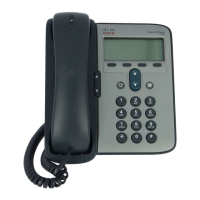Chapter 1 An Overview of the Cisco Unified IP Phone
Understanding the SIP Protocol
1-8
Cisco Unified IP Phone 7906G and 7911G Administration Guide for Cisco Unified CallManager 5.1
OL-11515-01
Related Topics
• Understanding Interactions with Other Cisco Unified Communications
Products, page 2-2
• Understanding the Phone Startup Process, page 2-8
• Network Configuration Menu, page 4-7
Understanding the SIP Protocol
Session Initiation Protocol (SIP) is the Internet Engineering Task Force (IETF)
standard for multimedia conferencing over IP. SIP is an ASCII-based,
application-layer control protocol (defined in RFC 3261) that can be used to
establish, maintain, and terminate calls between two or more endpoints.
Like other VoIP protocols, SIP is designed to address the functions of signaling
and session management within a packet telephony network. Signaling allows call
information to be carried across network boundaries. Session management
provides the ability to control the attributes of an end-to-end call.
Transport Layer
Security (TLS)
TLS is a standard protocol for
securing and authenticating
communications.
When security is implemented,
Cisco
Unified IP Phones use the TLS
protocol when securely registering
with Cisco
Unified CallManager.
Trivial File Transfer
Protocol (TFTP)
TFTP allows you to transfer files
over the network.
On the Cisco Unified IP Phone,
TFTP enables you to obtain a
configuration file specific to the
phone type.
TFTP requires a TFTP server in your
network, which can be automatically
identified from the DHCP server. If
more than one TFTP server is
running in your network, you must
manually assign a TFTP server to
each phone locally.
User Datagram Protocol
(UDP)
UDP is a connectionless messaging
protocol for delivery of data packets.
Cisco Unified IP Phones receive and
process UDP messages.
Table 1-1 Supported Networking Protocols on the Cisco Unified IP Phone (continued)
Networking Protocol Purpose Usage Notes

